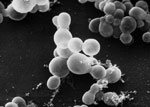Volume 31, Number 10—October 2025
Etymologia
Malassezia [mal″ə-sē′zhə]
Malassezia is a genus of basidiomycetous yeasts (Figure 1) that includes 18 validly published species, most of which are strictly lipophilic. These organisms are considered part of the normal cutaneous microbiota in humans and many animals. Malassezia spp. have also been associated with many skin diseases, including pityriasis versicolor, folliculitis, seborrheic dermatitis, dandruff, atopic dermatitis, and psoriasis.
In 1874, French histologist and anatomist Louis-Charles Malassez (Figure 2) isolated yeast cells from human dandruff scales and observed yeast with spherical and oval forms. Decades earlier, in 1846, Carl Ferdinand Eichstedt was the first to recognize the infectious nature of this fungus. He observed a journeyman with extensive pityriasis, which became subsequently known as Eichstedt’s disease.
The naming of this fungus was controversial because of disagreements over its classification, and it was initially named under the genus Pityrosporum. After years of debate, the genus was renamed Malassezia in 1984, honoring Malassez, who made major contributions to understanding this group of fungi, particularly in their taxonomic classification and lipophilic nature.
References
- Amend A. From dandruff to deep-sea vents: Malassezia-like fungi are ecologically hyper-diverse. PLoS Pathog. 2014;10:
e1004277 . DOIPubMedGoogle Scholar - Gaitanis G, Velegraki A, Mayser P, Bassukas ID. Skin diseases associated with Malassezia yeasts: facts and controversies. Clin Dermatol. 2013;31:455–63. DOIPubMedGoogle Scholar
- Morris DO, O’Shea K, Shofer FS, Rankin S. Malassezia pachydermatis carriage in dog owners. Emerg Infect Dis. 2005;11:83–8. DOIPubMedGoogle Scholar
- Rahimlou S, Amend AS, James TY. Malassezia in environmental studies is derived from human inputs. mBio. 2025;16:
e0114225 . DOIPubMedGoogle Scholar
Figures
Cite This ArticleOriginal Publication Date: September 18, 2025
Related Links
Table of Contents – Volume 31, Number 10—October 2025
| EID Search Options |
|---|
|
|
|
|
|
|


Please use the form below to submit correspondence to the authors or contact them at the following address:
Fabio C. Pogliani, Department of Internal Medicine, School of Veterinary Medicine and Animal Science, Universidade de São Paulo, Av. Prof. Dr. Orlando Marques de Paiva 87, São Paulo 05508-270, Brazil
Top